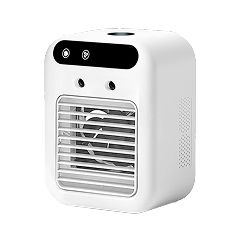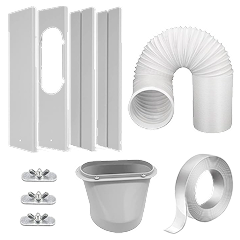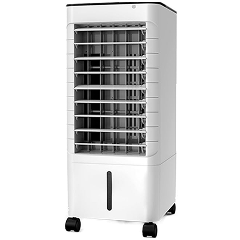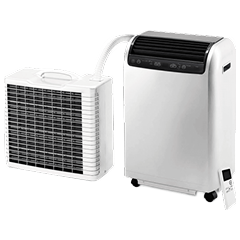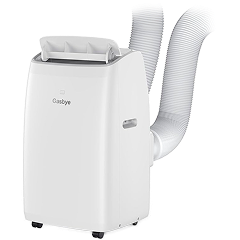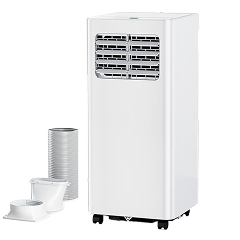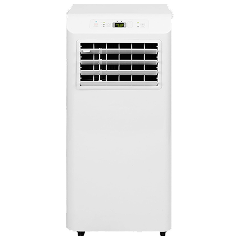Plus de dix ans d’expérience dans le secteur du chauffage et de la climatisation m’ont appris une chose : les climatiseurs mobiles remplissent un rôle limité, mais essentiel. Ils ne rivalisent pas avec les modèles de climatiseur sur fenêtre ou système central en termes de performance pure, mais ils apportent des solutions là où les autres échouent. Je les recommande surtout aux locataires qui ne peuvent pas apporter de modifications à leurs fenêtres, ou encore aux logements avec des ouvertures atypiques, ou quand on a tout simplement besoin d’un appareil mobile.
L’erreur la plus courante que je vois ? Penser qu’un climatiseur mobile offre la même efficacité qu’un modèle sur fenêtre ayant une puissance (BTU) identique. Ce n’est pas le cas, c’est de la physique. En effet, ces appareils rejettent de la chaleur dans la pièce qu’ils cherchent à refroidir, ce qui réduit leur capacité réelle de 20 à 30 %. Les appareils récents se sont toutefois considérablement améliorés. Les modèles actuels sont plus silencieux grâce à des compresseurs à vitesse variable, gèrent automatiquement la condensation, et certains sont dotés d’un système à double tuyau qui corrige les problèmes de pertes d’air des anciennes générations.
Avoir des attentes réalistes évite les mauvaises surprises. Les climatiseurs portables fonctionnent très bien pour rafraîchir une pièce, pas une maison entière. Leur coût de fonctionnement est plus élevé que les autres méthodes de refroidissement en raison de contraintes techniques. L’installation nécessite un peu de préparation : ce n’est pas juste un appareil que l’on branche et c’est tout. Connaître ces éléments dès le départ permet de choisir le bon modèle et de l’utiliser efficacement. C’est tout l’objectif de ce guide.
Comprendre le BTU : la base d’un bon rafraîchissement
Choisir la bonne puissance en BTU fait toute la différence entre une température agréable et un appareil qui tourne en continu sans vraiment rafraîchir la pièce. La plupart des gens se fient à des règles trop simplistes basées uniquement sur la surface, sans tenir compte des vrais facteurs qui influencent les besoins en climatisation.
Calculer ses besoins en BTU : bien plus que des mètres carrés
La règle de base, soit de viser environ 215 BTU par mètre carré, peut fonctionner pour une pièce parfaitement isolée dans des conditions idéales. Mais en réalité, ces cas sont très rares. Il vaut mieux viser 270 à 320 BTU/m² en cas de conditions plus exigeantes : soleil direct l’après-midi, grandes baies vitrées, ou encore espaces ouverts où la chaleur circule facilement. Prenons une chambre de 28 m² : il vous faut 7 500 à 9 000 BTU, et non les 6 000 BTU de base suggérés par un simple calcul.
L’usage de la pièce joue aussi un rôle important. Un bureau à domicile avec ordinateur et écran produit beaucoup de chaleur : il faut ajouter 500 à 750 BTU par poste de travail. Une cuisine demande plus de puissance à cause des appareils électroménagers. À l’inverse, une chambre équipée de rideaux occultants et avec peu d’électronique peut se contenter d’une puissance légèrement inférieure.
Pourquoi la règle standard ne suffit pas
La fameuse règle des 215 BTU par mètre carré repose sur des hypothèses rarement valables dans la réalité. Elle suppose des plafonds de 2,4 mètres, une bonne isolation, et peu de sources de chaleur. Or, beaucoup de logements ont des plafonds cathédrale, des fenêtres simple vitrage ou une isolation peu efficace. La véranda de 18 mètres carrés de mon voisin nécessitait par exemple 12 000 BTU. Elle se transformait en four solaire tous les après-midis… À l’inverse, un sous-sol de la même surface reste frais toute la journée avec seulement 6 000 BTU.
L’emplacement géographique joue aussi un rôle. Les besoins en BTU ne sont pas les mêmes à Paris et à Marseille, non seulement à cause des températures, mais aussi à cause du taux d’humidité, qui influence la façon dont les climatiseurs mobiles gèrent la condensation.
Facteurs de charge thermique augmentant les besoins de refroidissement
Plusieurs éléments peuvent faire grimper les besoins en refroidissement bien au-delà de la simple surface au sol :
- Fenêtres et exposition au soleil : les grandes fenêtres orientées sud ou ouest ajoutent plus de 1 000 BTU aux heures les plus chaudes de l’après-midi.
- Qualité de l’isolation : une mauvaise isolation des combles ou des murs non isolés augmentent les besoins de refroidissement de 30 à 50 %.
- Hauteur sous plafond : les plafonds cathédrale ou de plus de 3 mètres nécessitent 25 % de puissance supplémentaire en raison du volume d’air à traiter.
- Sources de chaleur : chaque personne ajoute environ 400 BTU, et les appareils électroniques ou électroménagers peuvent en générer bien davantage.
Erreurs de dimensionnement courantes
Le sous-dimensionnement survient lorsque l’on se focalise uniquement sur le prix d’achat sans tenir compte des performances de refroidissement. Imaginez un appareil de 8 000 BTU qui peine à refroidir une pièce qui en nécessite en réalité 12 000. Il tournera en continu, s’usera prématurément, et fera grimper votre facture d’électricité… au final, vous auriez dépensé moins en choisissant la bonne puissance dès le départ.
Un surdimensionnement pose d’autres problèmes. Un appareil trop puissant refroidit la pièce très vite, mais s’arrête avant d’avoir pu retirer l’humidité de l’air. Résultat : une sensation de froid humide, désagréable. Il s’allume et s’éteint sans arrêt, provoquant des variations brutales de température et usant le compresseur. Si vous installez un modèle de 14 000 BTU dans une petite chambre de 18 m², il s’activera toutes les quelques minutes, gaspillera de l’énergie, et ne rendra pas la pièce plus confortable.
Efficacité énergétique : indices EER, CEER et coûts d’exploitation
Vos factures d’électricité en été dépendent bien plus des indices d’efficacité énergétique que de la puissance en BTU. J’ai vu des climatiseurs de 8 000 BTU, très gourmands en énergie, coûter plus cher à faire fonctionner que des modèles de 12 000 BTU bien conçus. Comprendre les indices d’efficacité énergétique des climatiseurs mobiles peut vraiment faire la différence sur le long terme.
Comprendre l’indice EER et les repères cibles
L’EER (Energy Efficiency Ratio) correspond au rapport entre la capacité de refroidissement et la consommation électrique, mesuré dans des conditions de test en laboratoire. Par exemple, un appareil qui produit 10 000 BTU en consommant 1 000 watts a un EER de 10,0. Plus l’indice est élevé, plus l’appareil est économique à l’usage.
Voici ce à quoi vous pouvez vous attendre par gamme de prix :
- Les modèles entrée de gamme atteignent un EER de 8,5.
- Les modèles milieu de gamme se situent entre 9,5 et 10,5.
- Les modèles haut de gamme dépassent 11,0.
- Évitez les appareils avec un EER inférieur à 8,0, sauf si votre budget l’exige absolument ; ces modèles plus anciens gaspillent de l’électricité.
Pourquoi le CEER fournit une évaluation plus réaliste de l’efficacité
Le CEER (Combined Energy Efficiency Ratio) inclut la consommation en veille, ce que les tests EER ne prennent pas en compte. Les climatiseurs mobiles consomment de l’électricité pour l’affichage, les commandes ou encore les ventilateurs, même lorsque le compresseur est à l’arrêt… ce que le test EER ignore complètement.
Les indices CEER sont inférieurs de 0,5 à 1,0 point aux indices EER pour un même appareil. Cet écart reflète l’efficacité réelle lors d’une utilisation quotidienne avec plusieurs cycles marche/arrêt. Si vous comparez plusieurs modèles, le CEER donne une estimation plus fiable des coûts de fonctionnement que l’EER seul.
Exigences ENERGY STAR et garanties de performance
Le label ENERGY STAR atteste que les appareils ont passé avec succès les tests d’efficacité énergétique de base. Les petits appareils de moins de 8 000 BTU doivent atteindre un CEER de 10,0, les modèles de milieu de gamme de 8 000 à 13 999 BTU doivent atteindre un CEER de 9,5 et les appareils plus grands un CEER de 9,0. Il s’agit de notes plutôt générales, et non d’un palmarès de performance.
Ne partez pas du principe qu’un appareil certifié ENERGY STAR est forcément le plus économe. De nombreux appareils non certifiés surpassent les appareils certifiés en termes de consommation d’énergie. La certification garantit surtout un niveau minimum de performance et le respect de certaines normes de sécurité.
Calculer vos coûts de fonctionnement annuels
Vous avez besoin de trois données : la puissance (en watts), la durée d’utilisation quotidienne et votre tarif d’électricité. Voici le calcul de base :
1 200 watts × 8 heures × 0,12 € par kWh = 1,15 € par jour.
Sur 120 jours d’été, cela représente environ 140 € par saison de climatisation.
Les coûts réels fluctuent cependant fortement. Une maison mal isolée, une canicule prolongée, ou un réglage de thermostat trop bas peuvent facilement doubler cette estimation. Pensez aussi à vérifier votre tarif d’électricité réel : les prix sont souvent plus élevés en après-midi, justement quand les climatiseurs tournent le plus.
Coût initial vs économies d’énergie à long terme
Voici un exemple simple : un modèle à 400 € avec un EER de 8,5 consomme environ 180 € d’électricité par an. Un modèle plus efficace à 600 € avec un EER de 11,0 ne coûte que 140 € par an à faire fonctionner. Résultat : le modèle plus cher amortit ses 200 € de différence en 5 ans, puis continue à vous faire faire des économies chaque année.
Ce calcul devient encore plus avantageux dans les régions où l’électricité est chère ou si l’appareil fonctionne de nombreuses heures par jour. Dans les régions où le kilowattheure dépasse 0,20 €, un modèle plus efficace peut être rentabilisé en 2 à 3 ans, au lieu de 5 ans ou plus.
Conception à un tuyau vs deux tuyaux
La différence essentielle entre un climatiseur mobile à un tuyau et un modèle à deux tuyaux réside dans la gestion du flux d’air.
Les unités à tuyau unique utilisent l’air de la pièce pour refroidir le condenseur. Elles rejettent ensuite cet air chaud à l’extérieur. Cela crée une pression négative dans la pièce, ce qui fait entrer de l’air chaud de l’extérieur par les fissures, les interstices ou les ouvertures de votre logement.
Les unités à double tuyau utilisent des tuyaux d’admission et d’évacuation séparés. L’air extérieur refroidit le condenseur et est évacué sans affecter la pression ambiante.
Les climatiseurs à un tuyau mènent une bataille perdue d’avance. Voici ce qui se passe : votre climatiseur aspire l’air ambiant, le réchauffe tout en refroidissant le condenseur, puis le rejette à l’extérieur. Or, l’air doit bien provenir de quelque part pour remplacer celui qui a été évacué à l’extérieur. L’air chaud extérieur s’infiltre par les interstices des fenêtres, les fentes des portes, les prises électriques… par tous les petits passages possibles.
Les modèles à deux tuyaux règlent ce problème en séparant clairement l’air d’admission et l’air d’évacuation. Cette séparation nette supprime les problèmes de pression et améliore considérablement l’efficacité.
Les modèles à un tuyau, moins chers, se vendent mieux, car ils coûtent moins cher à l’achat et semblent plus simples à installer. Les performances sont moindres dans les espaces déjà étanches comme les garages. Pour un rafraîchissement localisé, comme pour se détendre confortablement à son bureau, ils sont également parfaits.
Je recommande les unités à double tuyau pour une efficacité de refroidissement maximale et des coûts réduits sur le long terme. Cela dit, les unités à tuyau unique conviennent parfaitement dans de nombreuses situations, notamment dans les garages ou les ateliers, où les grandes portes et les défauts d’étanchéité entraînent déjà souvent une forte infiltration d’air. Dans les pièces mal isolées ou peu étanches, la différence de performance entre un ou deux tuyaux est beaucoup moins marquée.
Contrôle de la température et précision
La précision du thermostat numérique influence directement le confort et la consommation d’énergie. Les bons appareils, avec une précision de ±0,5 °C, maintiennent une température stable sans les cycles marche-arrêt fastidieux des modèles bon marché. Un thermostat imprécis, avec une marge de ±1,5 °C, peut refroidir la pièce à 20 °C alors que vous souhaitez 22 °C, puis s’arrêter jusqu’à ce que la température grimpe à 24 °C ou plus. Résultat : des variations désagréables et un compresseur qui s’use plus vite en travaillant de manière inefficace.
Une mauvaise précision du thermostat gaspille de l’énergie en raison de schémas inefficaces. Les fortes variations de température forcent le compresseur à tourner plus longtemps pour compenser la chaleur accumulée pendant les phases d’arrêt. Comparez un appareil oscillant entre 20 °C et 24 °C à un appareil se maintenant entre 21 °C et 23 °C : l’appareil stable consomme nettement moins d’électricité. De plus, les démarrages fréquents usent prématurément le compresseur.
Les commandes analogiques à molette offrent une précision minimale et leur fiabilité diminue avec le temps à cause de l’usure mécanique. À l’inverse, les contrôles numériques permettent un réglage plus précis de la température, mais attention : tous les systèmes numériques ne se valent pas. Les unités dotées de capteurs de température séparés des cartes électroniques sont plus précises que celles dont les capteurs sont placés près de composants chauffants à l’intérieur de l’appareil. La position du capteur peut fausser les relevés de plusieurs degrés sur certains modèles.
Enfin, l’affichage de la température varie en utilité selon les appareils. Les modèles qui indiquent la température ambiante réelle sont très utiles pour comparer avec le réglage du thermostat. En revanche, afficher uniquement la température cible apporte peu d’intérêt pratique.
Certains appareils affichent les températures intérieure et extérieure. Cela peut paraître utile, mais les relevés extérieurs effectués par des capteurs situés près des tuyaux d’évacuation chauds donnent rarement des informations précises. Privilégiez les appareils affichant clairement la température ambiante actuelle, plutôt que des relevés multiples à la précision douteuse.
Niveau sonore : choisir un appareil qui ne perturbe pas votre quotidien
Les niveaux en décibels permettent de comparer le niveau sonore, mais la perception sonore réelle dépend aussi de la fréquence du son et de la conception du ventilateur. Un appareil de 50 dB avec un compresseur à haute fréquence agaçant est bien plus gênant qu’un appareil de 52 dB au son grave et régulier.
Voici quelques repères :
- 45 dB équivaut à une bibliothèque silencieuse.
- 50 dB équivaut à une pluie légère.
- 55 dB équivaut à un volume de conversation normal.
Pour une chambre, la plupart des gens auront besoin d’un appareil fonctionnant à moins de 50 dB pour dormir confortablement. Dans un salon, 52 à 55 dB restent acceptables sans gêner la télévision ou une conversation.
La technologie du compresseur a un impact important sur le niveau sonore et sa qualité. Les compresseurs classiques à marche/arrêt produisent un bruit net au démarrage et à l’arrêt, ainsi qu’un bourdonnement constant en fonctionnement.
Les compresseurs à vitesse variable fonctionnent plus doucement et silencieusement, éliminant les bruits de démarrage discordants qui réveillent les dormeurs légers. Les modèles à inverter sont généralement 3 à 5 dB plus silencieux que les modèles de base, tout en produisant un bourdonnement grave moins dérangeant qu’un sifflement mécanique aigu.
La conception du ventilateur contribue autant à la perception du bruit que le compresseur. Les appareils avec de grands ventilateurs tournant lentement déplacent le même volume d’air plus silencieusement que ceux utilisant de petits ventilateurs rapides. Des ventilateurs mal équilibrés provoquent des vibrations et des cliquetis qui rendent les décibels annoncés sans valeur. Jetez un œil aux avis pour repérer les mentions de vibrations ou de bruits parasites : cela indique des problèmes de qualité de fabrication que les fiches techniques ne révèlent pas.
Technologie avancée de compresseur et de refroidissement
Les compresseurs à vitesse variable représentent la plus grande avancée technologique de la dernière décennie en matière de clim mobile. Les systèmes classiques à marche/arrêt fonctionnent à pleine puissance jusqu’à atteindre la température souhaitée, puis s’arrêtent complètement jusqu’à ce que la température remonte.
Les modèles à vitesse variable modulent leur puissance en fonction des besoins réels de votre pièce. Au lieu de s’allumer et de s’éteindre cycliquement comme les anciens modèles, ils fonctionnent en continu à la vitesse nécessaire pour maintenir la température cible. Cette approche réduit le gaspillage d’énergie de 15 à 25 % tout en supprimant les fortes variations de température qui rendent les modèles bon marché si désagréables.
La technologie d’auto-évaporation varie considérablement d’un fabricant à l’autre. Les vrais systèmes utilisent la chaleur résiduelle du condenseur pour évaporer la majeure partie de la condensation, et ne nécessitent un drainage que lors de conditions de forte humidité.
Les arguments marketing se contentent de proposer des bacs de récupération plus grands ou un débit d’égouttement plus lent, tout en parlant d’« auto-évaporation ». Les bons systèmes éliminent la vidange manuelle dans 90 % des cas ; les versions douteuses nécessitent toujours de vider un réservoir chaque jour ou chaque semaine par temps humide.
La technologie inverter associe des compresseurs à vitesse variable à des systèmes de contrôle avancés, offrant ainsi la régulation de température la plus fluide disponible sur les climatiseurs mobiles. Ces systèmes ajustent en continu la vitesse du compresseur selon l’écart de température, maintenant la pièce à 0,5 à 1 °C près de la température voulue, contre 2 à 3 °C de variation avec les modèles classiques.
D’après mon expérience, les unités à inverter sont également 3 à 5 dB plus silencieuses que les systèmes standard, tout en consommant 20 à 30 % d’électricité en moins au cours des cycles quotidiens. Cette technologie coûte plus cher à l’achat, mais elle se rentabilise grâce à des coûts de fonctionnement réduits et un meilleur confort.
Fonctionnalités pratiques essentielles
Les climatiseurs mobiles offrent aujourd’hui une multitude de fonctionnalités. Certaines sont vraiment utiles, d’autres ne font que compliquer les choses. Voici celles qui comptent vraiment, et celles qui relèvent du simple argument marketing.
Programmation horaire et économies d’énergie
La programmation intelligente permet un prérefroidissement avant l’arrivée à la maison et un arrêt automatique quand personne n’occupe la pièce. Les fonctionnalités les plus utiles incluent une planification quotidienne, avec des programmes différents en semaine et le week-end, ainsi que des dérogations temporaires en cas de changement d’horaire. Les unités avec programmation sur 7 jours et plusieurs cycles quotidiens de marche/arrêt offrent la flexibilité nécessaire pour réaliser de réelles économies d’énergie.
Les minuteries simples avec compte à rebours sont bien moins utiles qu’un système de programmation complet. Privilégiez les appareils qui conservent les programmes en mémoire après une coupure de courant et permettent de modifier facilement les horaires, sans avoir à tout reprogrammer.
Redémarrage automatique après une coupure de courant
Le courant se coupe, revient, et votre climatiseur oublie tout. Sans redémarrage automatique, l’appareil revient aux paramètres usine, souvent avec vitesse de ventilation maximale et une température réglée à 22 °C. Cela gaspille de l’énergie et peut vous laisser en pleine chaleur si vous n’êtes pas là pour le reconfigurer.
Cela est particulièrement important pendant en période orageuse, où les microcoupures sont fréquentes. Les appareils qui mémorisent tous les paramètres, y compris les programmes horaires et les configurations du mode nuit, permettent une reprise automatique sans interruption.
Programmation du mode nuit et confort nocturne
Des modes nuit bien conçus ajustent progressivement la température de 1 à 2 °C sur plusieurs heures, pour s’adapter aux variations naturelles de température de votre corps pendant le sommeil. Cela maintient le confort tout en réduisant la consommation d’énergie de 10 à 15 % pendant la nuit. Les meilleurs systèmes ralentissent aussi la ventilation pour limiter les nuisances sonores.
Les modes nuit basiques se contentent d’augmenter la température d’un seul coup, ce qui peut vous donner trop chaud ou trop froid selon les conditions. Préférez les systèmes qui permettent de personnaliser la progression de température et la durée, plutôt qu’une programmation universelle.
Télécommande et affichage
Les télécommandes doivent inclure toutes les fonctionnalités fréquemment utilisées sans nécessiter de combinaisons de touches complexes. Les fonctionnalités importantes incluent le réglage de la température, la vitesse du ventilateur, la programmation horaire et la sélection du mode. Un écran rétroéclairé est utile pour les réglages de nuit, et l’affichage de la température actuelle permet de suivre les conditions réelles de la pièce.
Choisissez une télécommande avec de grands boutons bien lisibles, utilisables à au moins 6 mètres de distance. Assurez-vous qu’elle soit solide : les télécommandes fragiles se cassent facilement à l’usage. Les meilleurs modèles incluent un support magnétique ou un clip à fixer sur l’appareil, pour éviter de perdre la télécommande derrière un meuble.
Intégration domotique et contrôle via application
Les applications pour smartphone vous permettent de tout contrôler à distance. Allumez la climatisation avant de rentrer, surveillez votre consommation d’énergie et recevez des alertes lorsque vous devez nettoyer vos filtres. La plupart se connectent à Alexa, Google et Apple HomeKit pour les commandes vocales et la domotique.
Les fonctionnalités « smart » ajoutent toutefois de la complexité et des points de défaillance potentiels. Les connexions Wi-Fi peuvent devenir instables, les applications des fabricants peuvent cesser de recevoir des mises à jour et les services cloud peuvent parfois être hors ligne.
Choisissez des appareils issus de fabricants reconnus, bénéficiant d’une bonne note dans les boutiques d’applications et d’un historique de mises à jour récentes. Évitez les appareils qui dépendent du cloud pour fonctionner, même pour les fonctionnalités de base : un contrôle en Wi-Fi local est plus fiable qu’un système dépendant de serveurs distants.
Déshumidification et fonctionnement multimode
La capacité de déshumidification est primordiale dans les climats humides, où le retrait d’humidité est aussi important que la baisse de température pour le confort. Les appareils capables de retirer plus de 25 litres par jour conviennent bien aux besoins domestiques. Les modèles à plus faible capacité auront des difficultés dans les environnements côtiers ou subtropicaux.
Les modèles à refroidissement seul offrent une élimination basique de l’humidité, mais des modes dédiés de refroidissement et de déshumidification optimisent le cycle frigorifique pour extraire un maximum d’eau. Les modèles avec pompe à chaleur offrent une capacité de chauffage pour une utilisation toute l’année, ajoutent une fonction de chauffage pour un usage toute l’année, bien que leur efficacité baisse nettement en dessous de 5 °C en extérieur.
Le mode ventilation seule fait circuler l’air sans rafraîchir. Il est idéal par temps doux, lorsque vous souhaitez une circulation d’air sans besoin de vraie climatisation. Ce mode ne consomme que 50 à 100 watts, contre 800 à 1 500 watts en mode climatisation complète. Il est donc économique de maintenir un confort optimal même par temps clément.
Les différents modes consomment des quantités d’énergie différentes : la déshumidification seule consomme environ 60 à 70 % de la puissance de refroidissement maximale, tandis que la ventilation seule coûte moins cher qu’un ventilateur de plafond. Comprendre ces écarts de consommation permet d’optimiser le confort tout en maîtrisant sa facture d’électricité.
Installation et adaptation à la taille de la pièce
La compatibilité des kits de fenêtres est, à mon avis, la source de plus de difficultés d’installation que tout autre facteur. Les kits de base sont conçus pour des fenêtres à guillotine et coulissantes de 60 à 122 cm de large. Les fenêtres à battant, à auvent et les ouvertures très larges nécessitent des adaptateurs spéciaux ou des solutions sur mesure.
Mesurez toujours votre fenêtre avant l’achat : la hauteur, la largeur et la profondeur du cadre influencent l’étanchéité. De nombreux utilisateurs ne découvrent des problèmes de compatibilité qu’après le déballage, ce qui entraîne des courses de dernière minute en magasin de bricolage pour acheter mousse isolante et ruban adhésif afin de combler les fuites… au détriment de l’efficacité.
Ne vous fiez pas uniquement aux recommandations du fabricant concernant la taille de la pièce. Tenez également compte de la hauteur sous plafond, de la qualité de l’isolation, de l’exposition des fenêtres et des sources de chaleur, au-delà des calculs de base de superficie.
Une pièce de 28 m² avec des plafonds de 3 m et des fenêtres orientées à l’ouest aura besoin de beaucoup plus de puissance de refroidissement qu’un sous-sol de même surface. Veillez à ce que le tuyau d’évacuation de votre climatiseur mobile soit aussi court et droit que possible : chaque coude réduit l’efficacité du flux d’air.
Pour les installations complexes, comme les pièces sans fenêtres adaptées, vous pouvez évacuer l’air par un mur. Il vous faudra alors une scie-cloche de 15 cm pour percer le trou d’aération de votre clim portable (similaire à une sortie de sèche-linge, mais plus large).
Fonctionnalités intelligentes et connectivité
Les fonctionnalités connectées offrent un réel avantage lorsqu’elles incluent la surveillance à distance de la température, le suivi de la consommation d’énergie et une programmation flexible qui s’adapte à vos habitudes quotidiennes.
Les modèles avec Wi-Fi vous permettent de lancer le refroidissement à distance avant de rentrer chez vous, et de recevoir des alertes d’entretien quand les filtres doivent être nettoyés ou que le bac de vidange nécessite votre attention. L’intégration avec les principales plateformes de domotique telles qu’Alexa, Google Home ou Apple HomeKit simplifie le contrôle vocal et les scénarios d’automatisation.
Le surcoût lié à ces fonctionnalités intelligentes est surtout justifié pour les utilisateurs férus de technologie qui utiliseront réellement des fonctionnalités avancées de programmation et de suivi. Les modèles d’entrée de gamme dotés de commandes physiques fiables offrent souvent un meilleur rapport qualité/prix à long terme pour les utilisateurs recherchant une climatisation simple sans la complexité des systèmes connectés.
Marques leaders : analyse des fabricants selon un professionnel
Mon expérience avec les climatiseurs mobiles me permet de savoir quelles marques tiennent réellement leurs promesses, et lesquelles sont surtout fortes en marketing, mais offrent de mauvaises performances dans les conditions réelles.
Fiabilité des grandes marques et service après-vente
D’après mes recherches, LG et Frigidaire sont les marques qui génèrent le plus d’appels au service après-vente, mais pour des raisons différentes. Les appareils LG tombent moins souvent en panne, mais quand c’est le cas, les pièces sont plus chères et mettent plus de temps à arriver. Les modèles Frigidaire, en revanche, tombent en panne plus souvent, en particulier les cartes de contrôle et les capteurs de température, mais les pièces sont peu coûteuses et faciles à trouver. Whynter fabrique des appareils robustes à double tuyau qui nécessitent rarement des réparations, même si leur assistance clientèle peut être lente à réagir.
Haier et Midea (vendus sous différents noms de marque) sont de bonnes options économiques, avec une surprenante qualité de fabrication. Leur principal point faible est une assistance client inégale : certains conseillers connaissent bien les produits, d’autres beaucoup moins. Certains appareils Honeywell sont en réalité fabriqués par d’autres marques, ce qui entraîne une grande variation de qualité selon le fabricant réel.
Assistance clientèle et disponibilité des pièces détachées
Frigidaire est la marque qui se démarque pour la disponibilité des pièces. La plupart des distributeurs ont les composants courants en stock, et même les grandes surfaces proposent des pièces de base comme les filtres ou les tuyaux de vidange. LG dispose d’une excellente assistance technique avec du personnel qui connaît vraiment les produits, mais les délais de livraison des pièces sont plus longs. Black+Decker offre une assistance médiocre : les temps d’attente peuvent être longs et les conseillers lisent des scripts sans réelle connaissance des produits.
Whynter et SereneLife offrent une assistance clientèle correcte pour leurs prix, même si la livraison des pièces peut prendre une à deux semaines. Évitez les marques vendues exclusivement en ligne sans réseau de revendeurs locaux : vous serez livrés à vous-même en cas de problème.
Rapport qualité/prix vs haut de gamme : où va l’argent en plus
Les marques haut de gamme telles que LG, Honeywell et les modèles Frigidaire, plus onéreux, coûtent plus cher car elles utilisent de meilleurs compresseurs, des thermostats plus précis et des composants plus silencieux. Ces 200 à 300 € supplémentaires permettent généralement d’acheter des compresseurs à vitesse variable, des modèles à double tuyau et des pièces plus résistantes à une utilisation intensive.
Les marques d’entrée de gamme réduisent leurs coûts grâce à des commandes plus simples, un fonctionnement plus bruyant et des composants en plastique moins chers qui se fissurent avec le temps. Cependant, un appareil Midea à 300 € refroidit souvent aussi bien qu’un modèle haut de gamme à 600 €. Vous payez la différence pour le confort, les options supplémentaires, et la durabilité, pas pour la capacité de refroidissement de base.
Mes recommandations personnelles de marques
Pour plus de fiabilité et de longévité, je recommande les modèles à double tuyau Honeywell et LG, malgré leur coût initial plus élevé. Leurs compresseurs durent nettement plus longtemps que ceux des concurrents, et leur qualité de fabrication justifie le prix élevé. Whynter offre le meilleur rapport qualité/prix en matière d’unités à double tuyau, avec des performances solides sans le prix du haut de gamme.
Les acheteurs soucieux de leur budget devraient envisager les appareils à tuyau unique de Frigidaire ou Midea. Ils ne sont pas parfaits, mais les pièces détachées restent bon marché et faciles à trouver en cas de réparation. Évitez toute marque vendue exclusivement sur Amazon, sans réseau de distributeurs reconnu : le service sous garantie devient un cauchemar en cas de problème.
Erreurs d’achat courantes et comment les éviter
Je vois des gens commettre encore et encore les mêmes erreurs coûteuses. Voici comment éviter les plus graves, celles qui vous feront perdre de l’argent et du confort.
Se fier uniquement à la surface pour déterminer les besoins en BTU
La surface seule ne suffit pas à choisir la bonne puissance en BTU. J’ai vu des gens acheter des appareils incapables de répondre à leurs besoins, simplement parce qu’ils ont ignoré la hauteur sous plafond, la taille des fenêtres, la qualité de l’isolation, ou les sources de chaleur. Une véranda a besoin de beaucoup plus de puissance de refroidissement qu’un sous-sol, même si la surface est identique.
Ignorer les exigences électriques et d’installation jusqu’après l’achat
J’ai vu des propriétaires acheter des climatiseurs mobiles qui nécessitent soit un circuit de 20 ampères, soit qui ne s’adaptent pas à leurs fenêtres. Avant d’acheter, vérifiez les exigences électriques : les modèles plus puissants nécessitent souvent un circuit dédié, pas une prise partagée dans une chambre.
Prenez les mesures de votre fenêtre avant d’acheter : hauteur, largeur et profondeur du cadre. Assurez-vous que le kit de fenêtre fourni est compatible avec votre type de fenêtre. Les fenêtres à battants ou à auvent, en particulier, nécessitent souvent des adaptateurs spécifiques.
Choisir un modèle uniquement selon son prix d’achat sans considérer le coût total d’utilisation
Un appareil à 300 € avec une mauvaise efficacité énergétique peut coûter plus de 200 € par an en électricité, tandis qu’un modèle plus efficace à 500 € peut ne coûter que 140 € par an. Sur une durée de vie moyenne de 7 à 8 ans, le modèle plus efficace permet d’économiser plusieurs centaines d’euros, malgré un prix d’achat plus élevé.
La consommation d’énergie, les besoins de maintenance et la garantie doivent être pris en compte dans l’analyse des coûts totaux, plutôt que de se concentrer uniquement sur le prix en rayon, en ignorant les dépenses à long terme.
Négliger le niveau sonore et les fonctionnalités pratiques au quotidien
Un appareil bruyant devient inutilisable dans une chambre. Vous risquez de ne pas pouvoir dormir à cause du bruit. Les modèles sans minuterie correcte ou sans thermostat précis deviennent des sources de frustration quotidienne. Réfléchissez à l’endroit où vous utiliserez réellement l’appareil et aux fonctionnalités qui comptent vraiment, plutôt que de vous focaliser uniquement sur les BTU et le prix.
Entretien et longévité
L’entretien du filtre conditionne à la fois la qualité de l’air et l’efficacité du refroidissement tout au long de la durée de vie de votre appareil.
- Les filtres lavables doivent être nettoyés toutes les 2 à 3 semaines en cas d’utilisation intensive. Il suffit de les rincer à l’eau, de les laisser sécher complètement et de les réinstaller.
- Les filtres jetables coûtent entre 15 et 25 €, mais retiennent mieux les particules fines que les filtres lavables. Des filtres obstrués réduisent le flux d’air de 20 à 30 %, forçant les compresseurs à fonctionner plus longtemps, consommant plus d’électricité et offrant un refroidissement plus faible.
- Chaque système de drainage nécessite un entretien différent. Les unités à auto-évaporation gèrent automatiquement l’humidité normale, tandis que les systèmes manuels nécessitent une vidange régulière du réservoir.
Les signes indiquant qu’un climatiseur mobile a besoin d’une révision professionnelle incluent :
- Baisse de capacité de refroidissement malgré un filtre propre. Les fuites de réfrigérant ou l’usure du compresseur réduisent la puissance de refroidissement, même si le flux d’air est bon.
- Cycles marche/arrêt fréquents ou incapacité à atteindre la température cible. Problèmes de thermostat ou de système de réfrigération empêchant un fonctionnement normal.
- Bruits inhabituels tels que grincements, grincements ou cliquetis importants. Roulements usés, pièces desserrées ou problèmes de compresseur nécessitant une intervention immédiate.
- Formation de glace sur les serpentins ou les conduites. Un niveau de réfrigérant trop bas ou une obstruction du flux d’air entraînent une accumulation anormale de glace.
- Fuites d’eau ailleurs que par le drain. Une défaillance de composant interne ou un endommagement de la conduite de réfrigération nécessite un diagnostic professionnel.
- Problèmes électriques tels que des disjoncteurs qui sautent ou une odeur de brûlé. Les problèmes de câblage ou les défaillances de composants présentent des risques pour la sécurité et nécessitent une intervention immédiate.
La plupart des climatiseurs mobiles durent 7 à 10 ans avec un entretien correct. Les compresseurs tombent souvent en panne vers la 5e ou 6e année en cas d’utilisation intensive. Ne dépensez pas trop en réparations coûteuses sur un appareil ancien : les gains d’efficacité des modèles récents justifient souvent un remplacement plutôt qu’une réparation.
Quel climatiseur mobile vous convient le mieux ?
Le meilleur climatiseur mobile pour vous est la clim portable qui correspond à la taille de votre pièce et à votre budget.
- Pour les chambres de moins de 37 m², privilégiez un modèle silencieux (moins de 50 dB), avec un contrôle précis de la température et une consommation d’énergie réduite.
- Optez pour des unités à double tuyau pour les grands espaces de vie où l’efficacité nuit au confort et augmente vos factures d’électricité.
- Pour les garages et les ateliers, les unités à tuyau unique, plus bruyantes, fonctionnent généralement très bien.
- Petit budget ? Privilégiez les unités avec un EER supérieur à 9,0 et une fiabilité à toute épreuve, plutôt que des fonctionnalités sophistiquées que vous utiliserez rarement.
- Les amateurs de technologie apprécieront la connectivité intelligente et la programmation via application, mais je recommande souvent des modèles simples avec des commandes physiques fiables pour celles et ceux qui veulent simplement un bon refroidissement sans complexité.
Envisagez des alternatives si les climatiseurs mobiles ne répondent pas à vos besoins. Les climatiseurs de fenêtre offrent une efficacité supérieure de 20 à 30 % pour une installation permanente, tandis que les systèmes mini-split offrent des performances bien supérieures pour rafraîchir toute une pièce, malgré un coût d’installation plus élevé.
Je recommande la climatisation centrale pour rafraîchir plusieurs pièces en même temps. Cela dit, je continue à recommander les climatiseurs mobiles pour les logements en location, les besoins temporaires, et les espaces avec des fenêtres atypiques.
Mon conseil : commencez par choisir la bonne puissance en BTU, ensuite l’efficacité énergétique, puis le niveau sonore adapté à votre espace, et enfin la fiabilité, avant de vous intéresser aux fonctionnalités secondaires.


